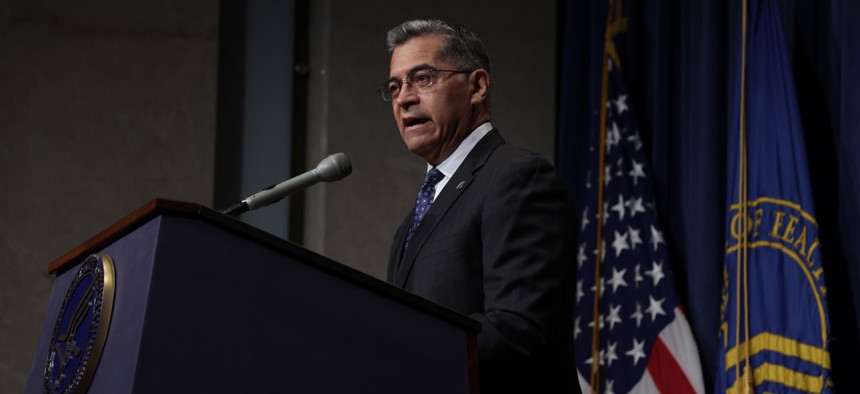
HHS Secretary Xavier Becerra holds a news conference in June. Alex Wong/Getty Images
The HHS to Industry: Let’s Connect on Medical Supply Chain Issues
The pandemic showed “the need for critical public health industrial investments at a scale never seen before in the United States,” an HHS official says.
The Health and Human Services Department has a new online tool to facilitate connections between government and industry officials to address medical supply chain vulnerabilities that were exacerbated by the COVID-19 pandemic.
Last week, HHS’ Administration for Strategic Preparedness and Response launched Industrial Base Expansion (IBx) Connect, Joe Hamel, acting deputy director of the unit’s Industrial Base Management and Supply Chain Office, wrote in an agency blog post. This comes after the pandemic showed “the need for critical public health industrial investments at a scale never seen before in the United States,” Hamel wrote, and builds on previous efforts by the department to address medical supply chain problems.
“The IBx Connect portal serves as [the preparedness agency’s] single point of entry for the submission of market research packages and related meeting requests from interested stakeholders regarding products they are developing that could be used to strengthen public health and medical supply chains,” according to the online page about the tool. “Through IBx Connect, [the agency] seeks information from stakeholders who are developing solutions to build and sustain a resilient medical industrial base in the U.S.”
Specifically, companies can request meetings with officials at the Administration for Strategic Preparedness and Response and other government experts to talk about technology and/or products in the works that they believe meet an emergency healthcare response need. These meetings will help companies understand more about what the agency is looking for, which officials describe as solutions related to the manufacturing of personal protective equipment, optimization of the supply chain, and testing and diagnostic devices.
“Funding is not guaranteed as a result of an IBx Connect meeting,” Hamel wrote. “However, technology, products, and supply chain manufacturing that [the Administration for Strategic Preparedness and Response] and other [U.S. government] Interagency experts determine to be a good fit can be directed to open solicitations, or to the right departments and agencies for additional non-financial support.”
The agency gave companies the following advice on how to get the most out of their meetings: know how their product fits into the government’s interest areas; explain why it is unique; be ready to discuss technical or regulatory challenges; come with any data gathered; consider the path to regulatory approval by the Food and Drug Administration (if relevant); and come with questions.
The preparedness agency’s announcement page notes that HHS’s Biomedical Advanced Research and Development Authority is accepting submissions on potential medical countermeasures to address health security threats, such as vaccines, drugs and targeted diagnostics. Companies can request meetings with research and development agency officials through the “TechWatch” platform.
Over the summer, HHS Secretary Xavier Becerra elevated the Office of the Assistant Secretary for Preparedness and Response to the Administration for Strategic Preparedness and Response, which is now a standalone agency within HHS like the FDA and Centers for Disease Control and Prevention.
“While the change in name and organizational status are effective immediately, the transition will be phased in over the next one to two years, and, when complete, will provide [the Administration for Strategic Preparedness and Response] with greater administrative capabilities to help it execute its work more effectively,” said a press release from HHS at the time. “This change will allow [the preparedness agency] to mobilize a coordinated national response more effectively and efficiently during future disasters and emergencies in close collaboration with its sister agencies.”







